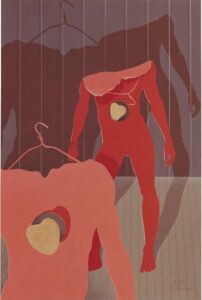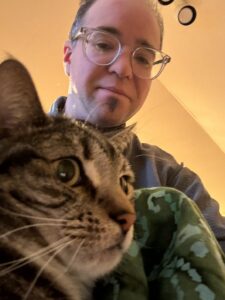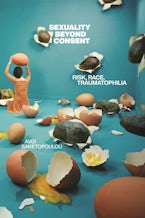Happy May, readers! I have been traveling a lot, writing a little, and gluing things together. Remember how, during the pandemic, those of us stuck at home went through a Little House on the Prairie phase of cooking and handicrafts to stay grounded in our bodies in our suddenly virtual social world? My Instant Pot is gathering dust, but my collage habit remains. The pleasure and challenge of amateur art-making is defending a space where self-evaluation doesn’t enter into the process. Though trying to refine my craft in terms of composition and editing, I’m working hard to keep ambition and comparison out of it. Save that for my literary career!
Caroline Osella, an anthropologist turned freelance writer and novelist, shares similar sentiments in her tongue-in-cheek Substack post “Make Shitty Crafts”. In elementary school, everyone’s encouraged to try painting, singing, and writing poems. But soon this democracy of creativity gives way to the academic Sorting Hat of “talent” and competitive testing that narrows students’ access to the creative professions. Social media threatens to recreate this joy-killing dynamic once we start comparing our quilts and apple pies to perfect photos online. Osella describes how her experiments with fabric dyeing and crochet made her happy no matter how irregularly they turned out.
There was a good slice of humour involved for us all in our house, especially at the beginning, as a kind of transitional mood over the period when everyone’s hopes for gorgeous outcomes to my studio time transmuted into pure and indifferent absorption in activity for me and into a sorrowful letting-go for everyone else. But, unlike those ironic millennials, deliberately setting out to do horrible stuff was never the initial goal. Product – satisfactory or disappointing as it might be – quickly faded out of any reckoning altogether, as I found myself completely taken up in process and flow and gradually developing a kindness towards myself, towards my lack of skill and towards everything that resulted. There’s no archness or camp irony at work here.
On his literary Substack, The Common Reader, Henry Oliver (Second Act: What Late Bloomers Can Tell You About Reinventing Your Life) takes up the question “Is Mary Oliver a good poet?” (And does it matter?) Like Stephen King or Rupi Kaur, Mary Oliver–presumably no relation to Henry?–is a frequent focus of the eternal rivalry between popular, accessible writers and obscure niche weirdos like yours truly. Henry quite convincingly argues why Mary’s work should not be reduced to the quotable platitudes that make the rounds online. She dares to be sincere and straightforward, to such an extent that her work has a transcendent quality, becoming a clear window through which we view the nonhuman world. Citing her “wild and precious life” poem, Henry notes:
If you only quote the last two lines, as happens so often, then you are taking this poem out of context. We do this to Kipling too, another victim of the “middlebrow” label. But he’s still a great poet. If is still a great poem. Just because lots of people turn a poem, or a quote, into the poetic equivalent of muzak doesn’t mean the poem is in fact muzak. Read this poem again. Mary Oliver is asking that final question in a very different manner to the way it is usually asked out of context.
I suppose it’s a special and rare irony to have your work be so popular that it’s underestimated. This past week, visiting the Museum of Modern Art in NYC, I was in the actual presence of paintings that have become so widely reproduced that it’s hard to see them with fresh eyes: Van Gogh’s “Starry Night”, for instance, or Picasso’s “Demoiselles d’Avignon”. It takes real self-discipline to sit down in front of these paintings, empty the mind of what you think you know about them, and let them speak to you. I couldn’t do that very well with the Van Gogh because it’s quite small and was surrounded by fans taking iPhone pictures of it, but its juxtaposition with Georges Méliès’ goofy 1902 silent film “A Trip to the Moon” brought out the painting’s previously unnoticed resonances with early science fiction.
The Summer 2023 issue of online lit mag Tyger Quarterly includes poet S. Yarberry’s imagined “interview” with William Blake. Both the questions and the answers are playful and visionary in a manner befitting the author of “Tyger! Tyger!”
Would wings be an improvement for the human body?
Flying is very fun although it’s not bad to save some fun things for the afterlife.
…
What two historical characters would you like to bring together?
God is a funny historical character and not one I’ve always liked. If everyone who believes in God (“God,“ of course, can and should be interpreted broadly, creatively) could meet God (which to me means to meet themselves more truly, more ardently), they might have a new outlook on the way things could be. That might be nice.
Billy Lezra’s visceral personal essay at Electric Lit, “I Don’t Know How to Live If My Anorexia Dies”, resists a predictable recovery arc in favor of examining how our strengths may be intertwined with a mental illness or addiction that people tell us to overcome. A self without this fundamental trait can feel too hard to imagine. I resonated with this passage in particular:
In her essay “Writing Shame,” Elspeth Probyn draws a connection between the act of writing and the experience of shame. She suggests that writing and shame go hand in hand because there is “a shame in being highly interested in something and unable to convey it to others.” As writers, we are required to wrestle with the question:what if no one cares about what we care to uncover? Or worse, what if people reduce and reject what we disclose?
Yes–my self-hating voice doesn’t say I’m a bad writer, it says “Nobody cares about what you care about.” It’s not imposter syndrome but weirdo syndrome.
Lezra’s author bio took me to Rough Cut Press, the queer lit mag where they are editor-in-chief, and this interview with inspirational nonbinary author and social media influencer Jeffrey Marsh. Marsh’s Buddhist-inspired advice helped me get through some difficult family conversations this week.
In an interview with PBS, you invited the interviewer to describe you in a word, and he said “light.” And then you said: “Well, you just described yourself.” I was curious about how you came to this understanding–that you are a mirror.
I realized quite a long time ago that my mission in life is to draw out what needs to be healed in people. Sometimes that is a great thing if they are in a place where that is what they want. But sometimes it gets ugly: I draw out their bigotry or whatever they need to get over in order to have peace in their lives. And they rebel, which is understandable. But my mission doesn’t change. What I’m here to do doesn’t change. And what I hope to be is a bookmark for unconditional love and acceptance until people realize that unconditional love is actually within them and has been the whole time. I’m always pointing people toward the realization that whatever they see in me is because they have it already.
…
I would like to ask you about anger. You write: “At its best, anger is a call to fairness and a hand stretched out in your direction, an invitation to honor how much you care.” How do you distinguish between generative anger and destructive anger?
Yes–what we might call righteous anger versus run-of-the-mill hate. To me, I think they’re one and the same. I’m going to give you a very non-binary answer: constructive and destructive anger both spring out of a sense of injustice. I would imagine that someone hateful hates me because there is some sense that my freedom is not available to them, which is an injustice: that I’m getting attention, that I deeply love myself, and that they’re not allowed to. And that sense of injustice creates a lot of anger, just from what I’ve observed. But anger can be a source for good because there’s a lot of injustice that ought to be overturned in this world. Anger is a friend. Anger is trying to tell you something. Jesus got very angry in the Bible, famously. And that story, as far as I understand it, is about injustice. So anger is human. Anger is a kindness. For so many of us who have been traumatized, the worst thing we can think of is inflicting trauma on other people. We tend to associate anger with one or both of our parents being very traumatic, violent, hateful, mean, being the chaos. And if you break anger away from those associations, it really is a story of injustice and sensations in your body. So anger can really be an invitation.
A word I’ve seen surface in your work is “nonviolence.” What does this idea mean to you?
I’m committed to nonviolence both internally and externally. And as we were discussing before, you almost can’t have one without the other. You can’t do activism to end the violence in the world without ending the internal violence as well.
What does it look like to be nonviolent with yourself?
Unconditional love. These phrases get thrown around and I’m guessing some people reading may be rolling their eyes. But what I mean is: even if something happens that doesn’t go well, even if you have feelings, you have trauma, you have things that are coming up…can you love yourself in every single situation? To me, judging yourself, hating yourself, those voices inside your head saying, “Why’d you do that?”, “They’re going to laugh at you,” “You’re so stupid”– that’s internal violence. And if you’re going to commit yourself to nonviolence and commit yourself to be nonviolent in every possible situation, that is a wide-open invitation for life to bring in things that may challenge you because you’ve committed to facing challenges.
Marsh’s latest book is called Take Your Own Advice. It’s about learning to honor your own needs as an empath or trauma survivor. Added to my long wishlist!
Also from Electric Lit, I recommend Laura M. Martin’s salty essay, “Fake Authenticity Is Toxic, and So Are Iowa-Style Writing Workshops”. In it she slams the encounter-group model of writing workshops where the author stays silent while their classmates gang up on them with feedback. She compares it to a meet-up series she tried, Connection Games, whose social norms ended up pressuring participants to share vulnerable feelings more quickly than wanted to. “Unnerving people by oversharing and demanding reciprocal vulnerability” is at best untrained group therapy, at worst a technique for pick-up artists to neg women.
The game assumes honesty from others; it requires trusting what they say over your own impressions…
In both writing workshops and Authentic Relating, participants are expected to share deeply personal information with people they don’t know and may not even like or be comfortable with. Both spaces require vulnerability without providing the room to acknowledge discomfort or push back against assumptions…
“Authenticity” has become code for ignoring the impact of our behavior on the people around us, being unattuned to their responses. Others will be freer, the guidelines state, if they don’t have to worry about your “unspoken needs.” But a lack of concern about the feelings of other people isn’t authenticity, it’s immaturity…
…
I hated writing workshops, but I also believed they were necessary. How could a method used by dozens of universities for over seventy years be wrong? Once, I voiced concern to other members of my cohort. They said they found the criticism valuable, but after graduation, most of them stopped writing entirely.
If we make people feel unsafe, we aren’t seeing their true selves; we are seeing their responses to threat. Forcing personal disclosures and giving unsolicited “feedback” puts us in a state where self-reflection is impossible. Who can work on self-improvement when they’re under attack? Safety is a necessary prerequisite for connection and growth. It must come first.







